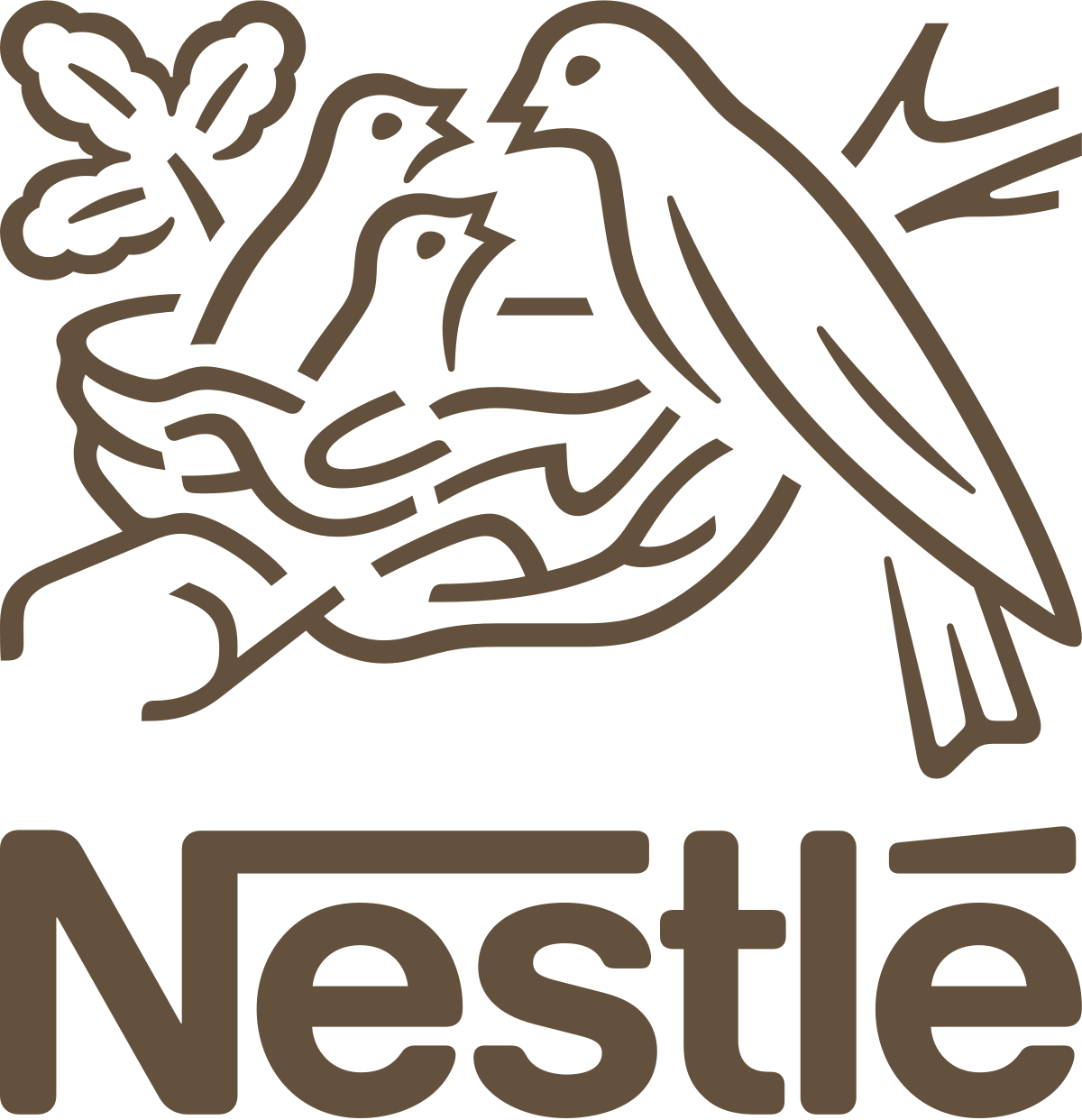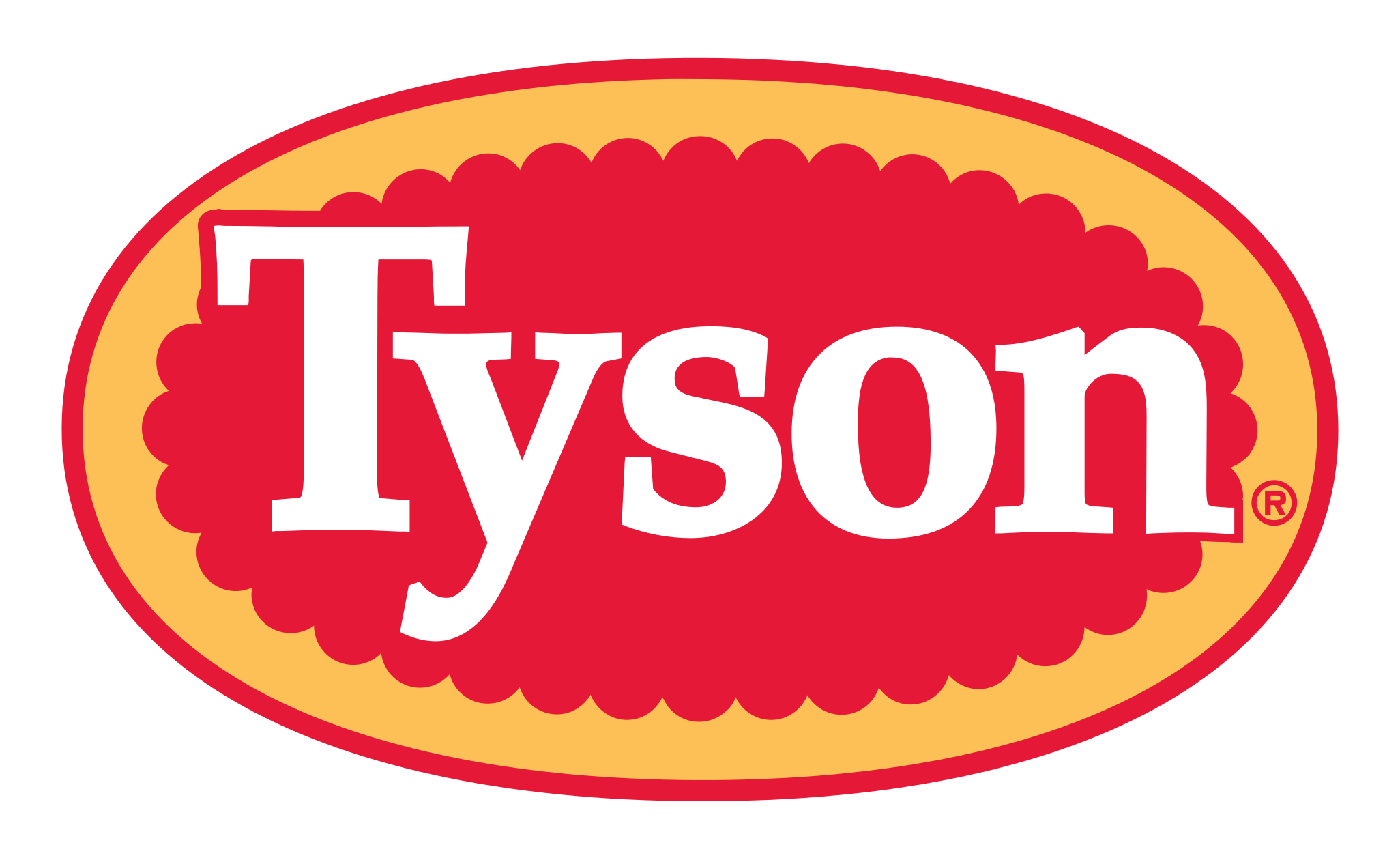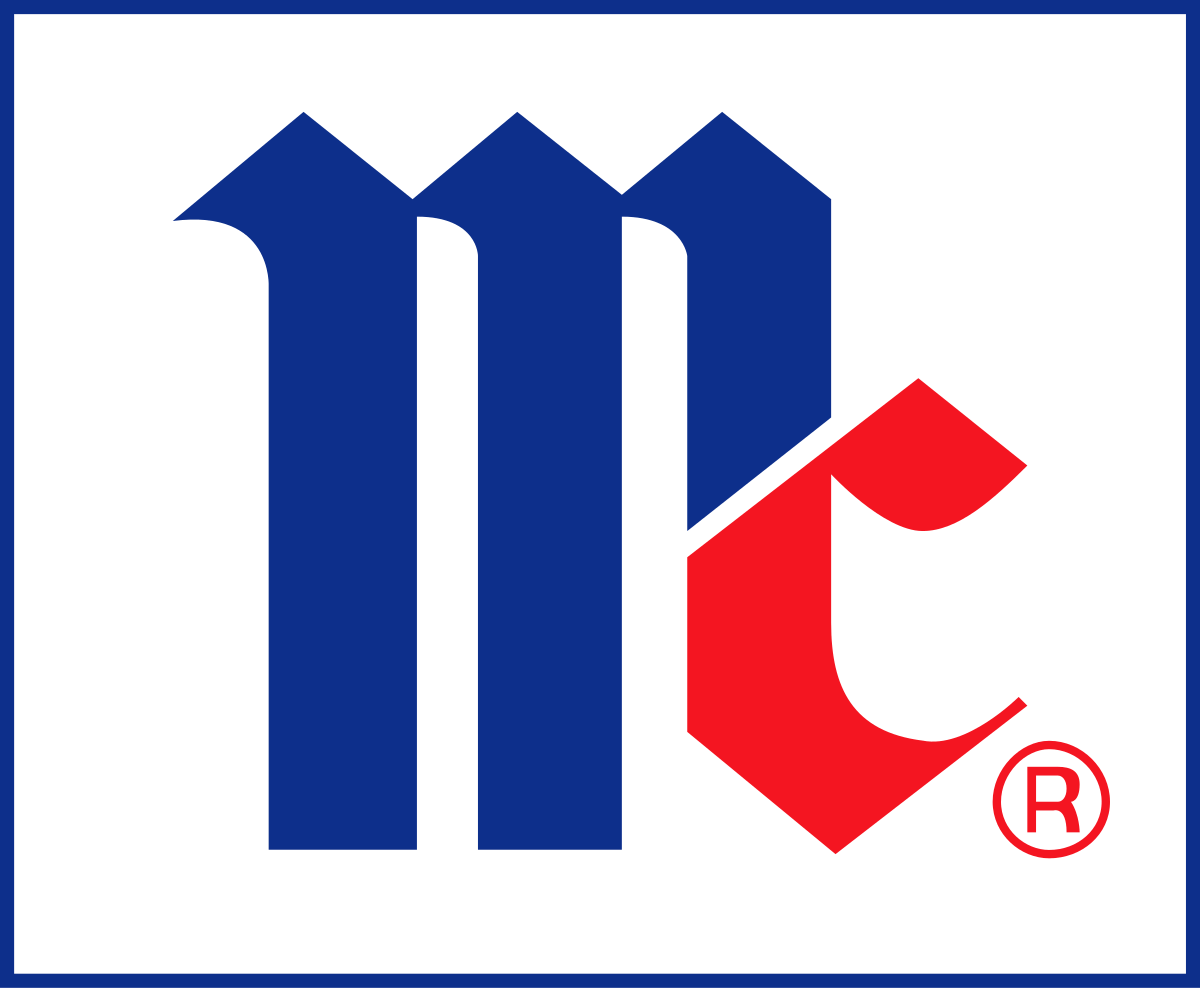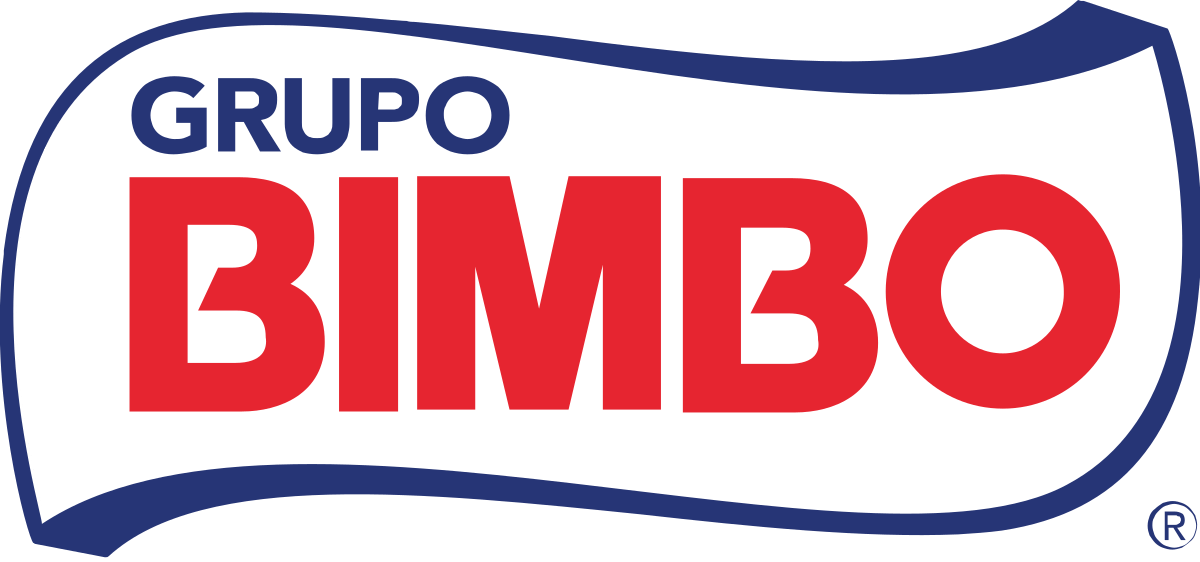Global Native Whey Protein Market: By Type, By Form, By Application, By Sales Channel, By Region & Segmental Insights Trends and Forecast, 2024 – 2034
- Industry: Food & Beverages
- Report ID: TNR-110-1260
- Number of Pages: 420
- Table/Charts : Yes
- August, 2024
- Base Year : 2024
- No. of Companies : 10+
- No. of Countries : 29
- Views : 10088
- Covid Impact Covered: Yes
- War Impact Covered: Yes
- Formats : PDF, Excel, PPT
Native whey protein, extracted directly from skimmed milk without the use of enzymes, is known for its superior nutritional profile, high bioavailability, and minimal processing, making it a preferred choice among health-conscious consumers. The native whey protein market is being driven by the growing consumer preference for natural and clean-label products, the increasing prevalence of lifestyle-related diseases, and the expanding sports nutrition market.
Market Size and Growth
As of 2023, the global native whey protein market was valued at approximately US$ 13.2 Bn and is projected to grow at a compound annual growth rate (CAGR) of 6.5% from 2024 to 2034. By the end of the forecast period, the market is expected to reach a value of around US$ 28.9 Bn. The growth is attributed to the increasing adoption of whey protein in various applications, including dietary supplements, functional foods, beverages, and personal care products.
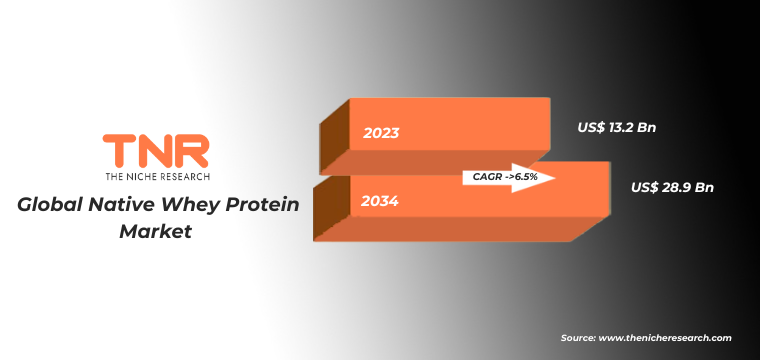
Key Market Drivers
- Rising Health Consciousness: The global increase in health awareness and the growing trend towards fitness have led to a surge in demand for protein supplements, particularly whey protein, which is considered a high-quality protein source. This trend is particularly strong in developed regions such as North America and Europe, where consumers are increasingly opting for protein-rich diets.
- Growing Sports Nutrition Market: The expanding sports nutrition market is another significant driver of the native whey protein market. Athletes and fitness enthusiasts prefer native whey protein for its high leucine content, which supports muscle protein synthesis and recovery. This has led to increased consumption of whey protein supplements and sports drinks.
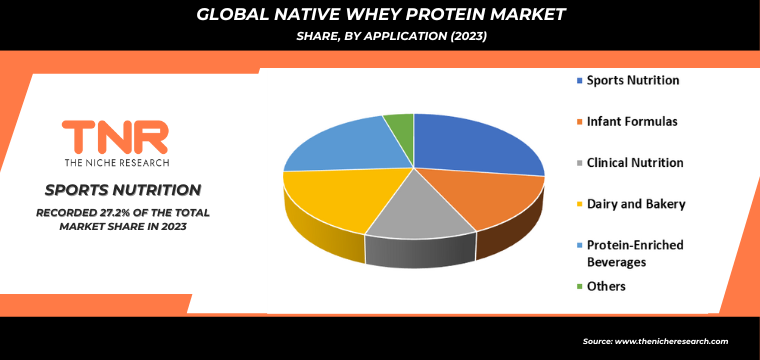
- Clean Label and Natural Products Demand: Consumers are increasingly seeking clean-label products with minimal processing and natural ingredients. Derived directly from milk, native whey protein aligns perfectly with the growing demand for natural and minimally processed ingredients, driving its adoption across various applications
- Technological Advancements: Advancements in protein extraction and processing technologies have led to the production of high-purity native whey protein with enhanced functional properties. This has expanded its application in various industries, including food and beverages, personal care, and pharmaceuticals.
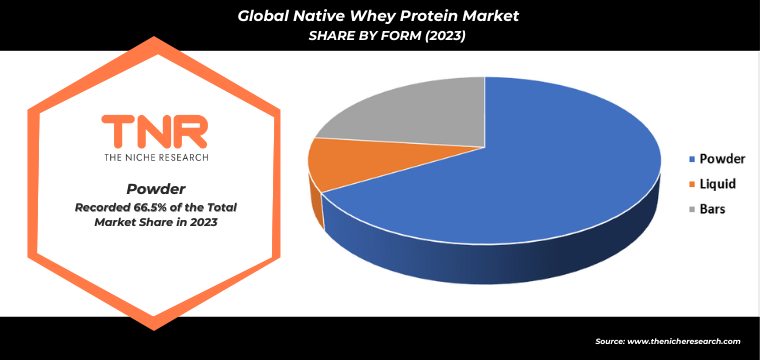
Market Segmentation
Global Native Whey Protein Market is segmented based on type, form, application, distribution channel, and region.
By Type
- Concentrate
- Isolate
- Hydrolyzed
Native whey protein isolate is the dominant segment, accounting for over 60.5% of the market share in 2023, due to its higher protein content and better solubility compared to concentrates. This dominance is primarily attributed to its higher protein content, which typically exceeds 90%, and its superior solubility compared to whey protein concentrates. These characteristics make whey protein isolate a preferred choice among consumers, particularly in the sports nutrition and dietary supplements sectors. Athletes and fitness enthusiasts often prioritize protein purity and bioavailability to support muscle recovery and growth, making isolates an ideal option. Additionally, native whey protein isolate is low in fat and lactose, which further enhances its appeal to individuals with lactose intolerance or those following specific dietary regimens. The demand for isolates is also driven by the growing trend of clean-label products, as consumers seek supplements that offer high protein content without unnecessary additives. Companies like Glanbia Nutritionals and Arla Foods Ingredients have capitalized on this demand by offering high-quality native whey protein isolates tailored for the sports nutrition market, further solidifying the segment’s leadership in the industry.
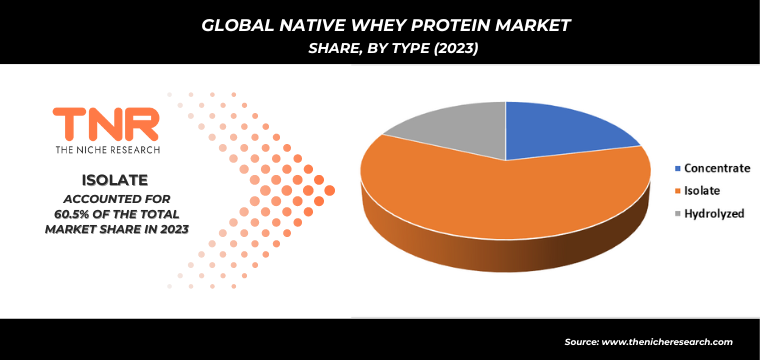
By Sales Channel
- Online
- E-Commerce Platforms
- Company Websites
- Offline
- Specialty Stores
- Supermarkets and Hypermarkets
- Others
The online distribution channel is expected to witness the fastest growth during the forecast period, driven by the increasing penetration of e-commerce platforms and the convenience of online shopping. One major driver is the increasing penetration of e-commerce platforms such as Amazon, Alibaba, and Walmart’s online store, which have made native whey protein products more accessible to a broader audience. These platforms not only offer a wide variety of products but also provide consumers with the convenience of comparing prices, reading customer reviews, and accessing detailed product information. Additionally, the convenience of online shopping allows consumers to purchase native whey protein products from the comfort of their homes at any time, catering to the fast-paced lifestyles of modern consumers. This ease of access, combined with the growing trend of health and fitness, is propelling the demand for native whey protein through online channels. For example, companies like Glanbia Nutritionals and Arla Foods Ingredients have increasingly partnered with e-commerce platforms to reach a wider audience, offering exclusive online deals and subscriptions to cater to the growing demand. This trend is further amplified by the rise of direct-to-consumer (DTC) brands, which are leveraging social media and digital marketing strategies to target health-conscious consumers directly through online channels.
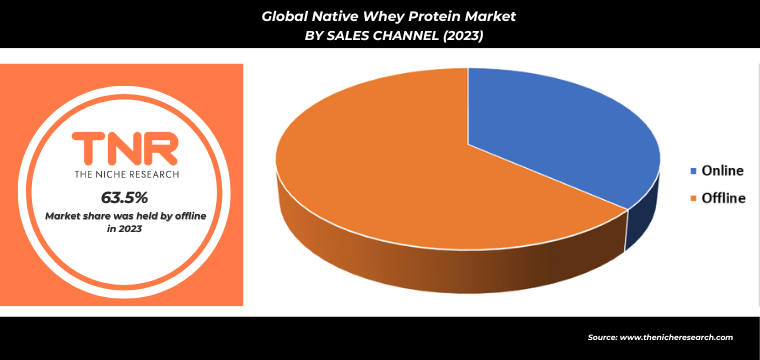
Regional Insights: Global Native Whey Protein Market
North America stands as the largest native whey protein market, capturing over 35.4% of the global market share in 2023. This region’s dominance is fueled by several key factors, including a robust health and fitness trend that has seen a significant rise in the number of health-conscious consumers and fitness enthusiasts. The well-established sports nutrition industry in North America, with its wide range of protein supplements and functional foods, plays a critical role in sustaining the high demand for native whey protein. Additionally, the increasing prevalence of lifestyle-related diseases such as obesity, diabetes, and cardiovascular conditions has prompted a growing number of consumers to adopt protein-rich diets as part of their health management strategies. The strong presence of leading market players, coupled with a mature distribution network and a high level of consumer awareness, further cements North America’s position as the leading market for native whey protein products. This trend is likely to continue, propelled by ongoing innovations in product development and marketing efforts that emphasize the health advantages of native whey protein.
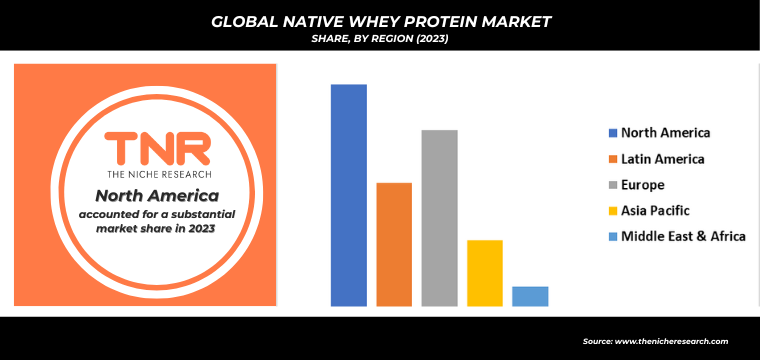
Competitive Insights: Global Native Whey Protein Market
A few of the major native whey protein market participants are listed below:
- Agropur Inc
- Arla Foods
- Carbery
- Fonterra Co-Operative Group Limited
- FrieslandCampina Ingredients
- Glanbia PLC (Optimum Nutrition)
- Ingredia SA
- Lactalis Ingredients
- Leprino Foods
- MILEI GmbH
- Olympian Labs, Inc.
- Reflex Nutrition
- Other Market Participants
For instance, in 2023, Glanbia Nutritionals launched a new range of native whey protein products specifically designed for the sports nutrition market, offering enhanced solubility and flavor profiles.
Global Native Whey Protein Market
| Report Specifications | Details |
| Market Revenue in 2023 | US$ 13.2 Bn |
| Market Size Forecast by 2034 | US$ 28.9 Bn |
| Growth Rate (CAGR) | 6.5% |
| Historic Data | 2016 – 2022 |
| Base Year for Estimation | 2023 |
| Forecast Period | 2024 – 2034 |
| Report Inclusions | Market Size & Estimates, Market Dynamics, Competitive Scenario, Trends, Growth Factors, Market Determinants, Key Investment Segmentation, Product/Service/Solutions Benchmarking |
| Segments Covered | By Type, By Form, By Application, By Sales Channel, By Region |
| Regions Covered | North America, Europe, Asia Pacific, Middle East & Africa, Latin America |
| Countries Covered | U.S., Canada, Mexico, Rest of North America, France, The UK, Spain, Germany, Italy, Nordic Countries (Denmark, Finland, Iceland, Sweden, Norway), Benelux Union (Belgium, The Netherlands, Luxembourg), Rest of Europe, China, Japan, India, New Zealand, Australia, South Korea, Southeast Asia (Indonesia, Thailand, Malaysia, Singapore, Rest of Southeast Asia), Rest of Asia Pacific, Saudi Arabia, UAE, Egypt, Kuwait, South Africa, Rest of Middle East & Africa, Brazil, Argentina, Rest of Latin America |
| Key Players | Agropur Inc, Arla Foods, Carbery, Fonterra Co-Operative Group Limited, FrieslandCampina Ingredients, Glanbia PLC (Optimum Nutrition), Ingredia SA, Lactalis Ingredients, Leprino Foods, MILEI GmbH, Olympian Labs, Inc., Reflex Nutrition |
| Customization Scope | Customization allows for the inclusion/modification of content pertaining to geographical regions, countries, and specific market segments. |
| Pricing & Procurement Options | Explore purchase options tailored to your specific research requirements |
| Contact Details | Consult With Our Expert
Japan (Toll-Free): +81 663-386-8111 South Korea (Toll-Free): +82-808- 703-126 Saudi Arabia (Toll-Free): +966 800-850-1643 United Kingdom: +44 753-710-5080 United States: +1 302-232-5106 E-mail: askanexpert@thenicheresearch.com
|
Global Native Whey Protein Market
By Type
- Concentrate
- Isolate
- Hydrolyzed
By Form
- Powder
- Liquid
- Bars
By Application
- Sports Nutrition
- Infant Formulas
- Clinical Nutrition
- Dairy and Bakery
- Protein-Enriched Beverages
- Others
By Sales Channel
- Online
-
- E-Commerce Platforms
- Company Websites
- Offline
-
- Specialty Stores
- Supermarkets and Hypermarkets
- Others
By Region
- North America (U.S., Canada, Mexico, Rest of North America)
- Europe (France, The UK, Spain, Germany, Italy, Nordic Countries (Denmark, Finland, Iceland, Sweden, Norway), Benelux Union (Belgium, The Netherlands, Luxembourg), Rest of Europe)
- Asia Pacific (China, Japan, India, New Zealand, Australia, South Korea, Southeast Asia (Indonesia, Thailand, Malaysia, Singapore, Rest of Southeast Asia), Rest of Asia Pacific)
- Middle East & Africa (Saudi Arabia, UAE, Egypt, Kuwait, South Africa, Rest of Middle East & Africa)
- Latin America (Brazil, Argentina, Rest of Latin America)
Report Layout:
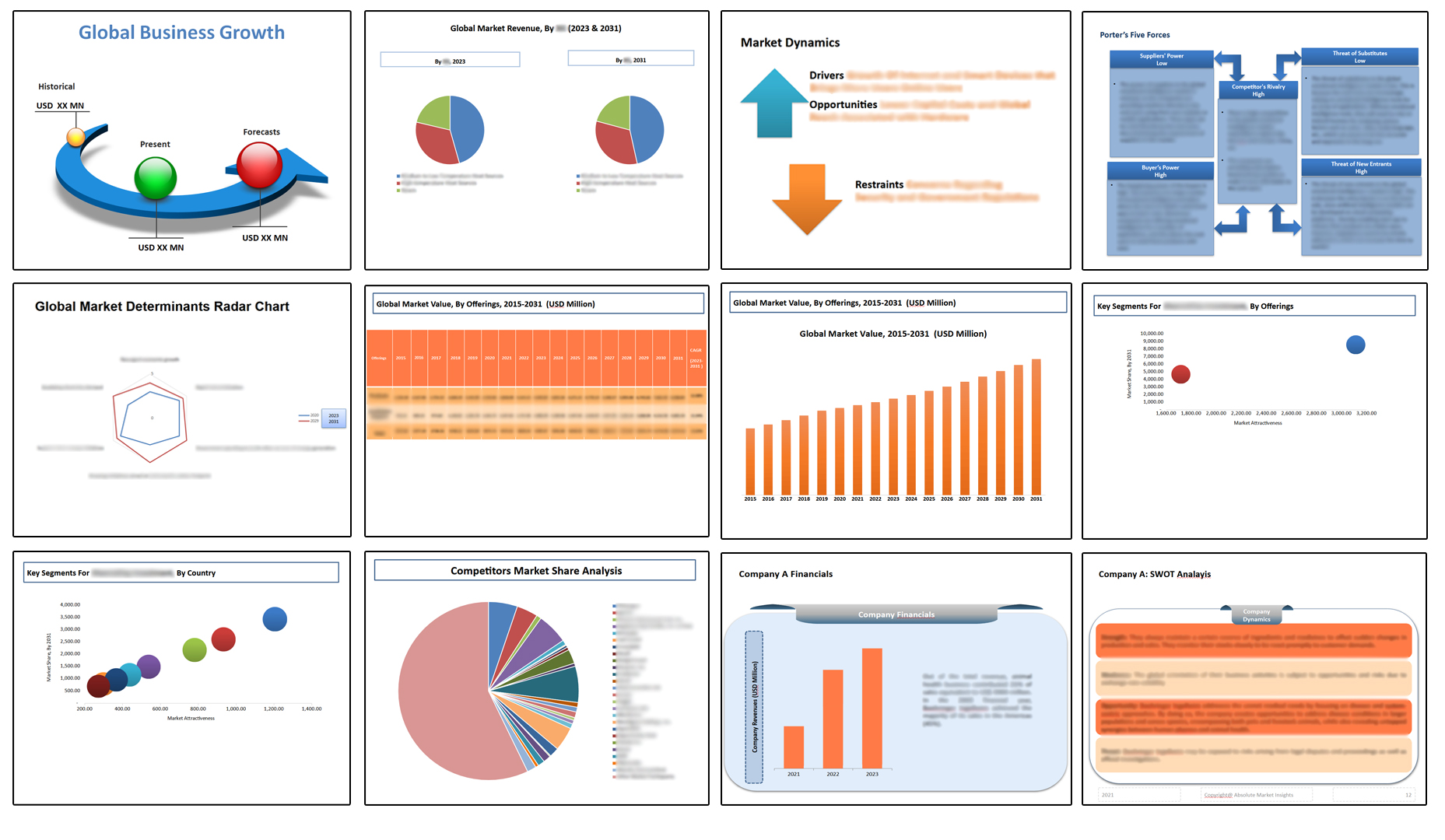
Table of Contents
Note: This ToC is tentative and can be changed according to the research study conducted during the course of report completion.
**Exclusive for Multi-User and Enterprise User.
Global Native Whey Protein Market
By Type
- Concentrate
- Isolate
- Hydrolyzed
By Form
- Powder
- Liquid
- Bars
By Application
- Sports Nutrition
- Infant Formulas
- Clinical Nutrition
- Dairy and Bakery
- Protein-Enriched Beverages
- Others
By Sales Channel
- Online
-
- E-Commerce Platforms
- Company Websites
- Offline
-
- Specialty Stores
- Supermarkets and Hypermarkets
- Others
By Region
- North America (U.S., Canada, Mexico, Rest of North America)
- Europe (France, The UK, Spain, Germany, Italy, Nordic Countries (Denmark, Finland, Iceland, Sweden, Norway), Benelux Union (Belgium, The Netherlands, Luxembourg), Rest of Europe)
- Asia Pacific (China, Japan, India, New Zealand, Australia, South Korea, Southeast Asia (Indonesia, Thailand, Malaysia, Singapore, Rest of Southeast Asia), Rest of Asia Pacific)
- Middle East & Africa (Saudi Arabia, UAE, Egypt, Kuwait, South Africa, Rest of Middle East & Africa)
- Latin America (Brazil, Argentina, Rest of Latin America)
The Niche Research approach encompasses both primary and secondary research methods to provide comprehensive insights. While primary research is the cornerstone of our studies, we also incorporate secondary research sources such as company annual reports, premium industry databases, press releases, industry journals, and white papers.
Within our primary research, we actively engage with various industry stakeholders, conducting paid interviews and surveys. Our meticulous analysis extends to every market participant in major countries, allowing us to thoroughly examine their portfolios, calculate market shares, and segment revenues.
Our data collection primarily focuses on individual countries within our research scope, enabling us to estimate regional market sizes. Typically, we employ a bottom-up approach, meticulously tracking trends in different countries. We analyze growth drivers, constraints, technological innovations, and opportunities for each country, ultimately arriving at regional figures.Our process begins by examining the growth prospects of each country. Building upon these insights, we project growth and trends for the entire region. Finally, we utilize our proprietary model to refine estimations and forecasts.
Our data validation standards are integral to ensuring the reliability and accuracy of our research findings. Here’s a breakdown of our data validation processes and the stakeholders we engage with during our primary research:
- Supply Side Analysis: We initiate a supply side analysis by directly contacting market participants, through telephonic interviews and questionnaires containing both open-ended and close-ended questions. We gather information on their portfolios, segment revenues, developments, and growth strategies.
- Demand Side Analysis: To gain insights into adoption trends and consumer preferences, we reach out to target customers and users (non-vendors). This information forms a vital part of the qualitative analysis section of our reports, covering market dynamics, adoption trends, consumer behavior, spending patterns, and other related aspects.
- Consultant Insights: We tap into the expertise of our partner consultants from around the world to obtain their unique viewpoints and perspectives. Their insights contribute to a well-rounded understanding of the markets under investigation.
- In-House Validation: To ensure data accuracy and reliability, we conduct cross-validation of data points and information through our in-house team of consultants and utilize advanced data modeling tools for thorough verification.
The forecasts we provide are based on a comprehensive assessment of various factors, including:
- Market Trends and Past Performance (Last Five Years): We accurately analyze market trends and performance data from preceding five years to identify historical patterns and understand the market’s evolution.
- Historical Performance and Growth of Market Participants: We assess the historical performance and growth trajectories of key market participants. This analysis provides insights into the competitive landscape and individual company strategies.
- Market Determinants Impact Analysis (Next Eight Years): We conduct a rigorous analysis of the factors that are projected to influence the market over the next eight years. This includes assessing both internal and external determinants that can shape market dynamics.
- Drivers and Challenges for the Forecast Period:Identify the factors expected to drive market growth during the forecast period, as well as the challenges that the industry may face. This analysis aids in deriving an accurate growth rate projection.
- New Acquisitions, Collaborations, or Partnerships: We keep a close watch on any new acquisitions, collaborations, or partnerships within the industry. These developments can have a significant impact on market dynamics and competitiveness.
- Macro and Micro Factors Analysis:A thorough examination of both macro-level factors (e.g., economic trends, regulatory changes) and micro-level factors (e.g., technological advancements, consumer preferences) that may influence the market during the forecast period.
- End-User Sentiment Analysis: To understand the market from the end-user perspective, we conduct sentiment analysis. This involves assessing the sentiment, preferences, and feedback of the end-users, which can provide valuable insights into market trends.
- Perspective of Primary Participants: Insights gathered directly from primary research participants play a crucial role in shaping our forecasts. Their perspectives and experiences provide valuable qualitative data.
- Year-on-Year Growth Trend: We utilize a year-on-year growth trend based on historical market growth and expected future trends. This helps in formulating our growth projections, aligning them with the market’s historical performance.
Research process adopted by TNR involves multiple stages, including data collection, validation, quality checks, and presentation. It’s crucial that the data and information we provide add value to your existing market understanding and expertise. We have also established partnerships with business consulting, research, and survey organizations across regions and globally to collaborate on regional analysis and data validation, ensuring the highest level of accuracy and reliability in our reports.
